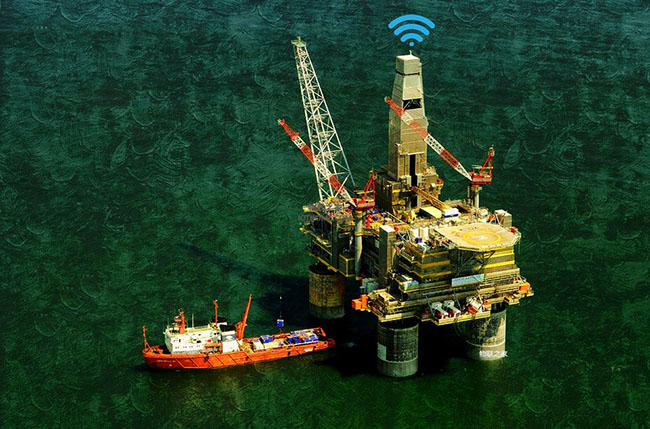Oil and gas (O&G) production is highly complex and unstable. The remoteness and isolation of offshore drilling platforms makes it difficult for offshore oil and gas companies to gain timely and accurate visibility into their ongoing production. This means operators often don’t know when machine and process variables are out of specification, potentially leading to asset failure and costly downtime. Worse, inadequate monitoring capabilities can lead to catastrophic explosion events that can wreak havoc on the environment, worker lives, and company credibility. Today, Internet of Things (IoT) technology brings endless opportunities for reliable and cost-effective maritime monitoring.


Connectivity barriers for offshore rig monitoring
To optimize efficiency and safety, upstream offshore oil and gas production requires round-the-clock monitoring of various equipment (pipelines, valves, wellheads, storage tanks, etc.) and parameters (temperature, vibration, pressure, flow rate, corrosion, gas leakage, etc.). Traditional communications solutions are either limited, expensive or cumbersome for connecting the large number of disparate assets on offshore drilling platforms. Wired infrastructure such as SCADA systems, while ideal for real-time control tasks, are not designed for data collection and therefore cannot be used for remote monitoring. Cellular mobile connectivity may not exist in the ocean. Furthermore, building a mesh network is often a difficult task given the sheer size and complex and dense structure of oil drilling platforms. Due to their seamlessness and ubiquity, satellite networks have become the most common choice for wireless implementation at sea. However, high costs mean that satellite networks mainly involve high-bandwidth voice and data transmission while connecting only a few high-value critical data points.
Due to a lack of cost-effective and scalable communications solutions, oil and gas companies used to rely heavily on manual data reading and visual inspections to monitor much of their operations, equipment and facilities. Needless to say, this is highly inefficient and error-prone, while exposing workers to significant site hazards and hazards.
The rise of IoT technology and next-generation connectivity
Emerging IoT connectivity solutions such as Low Power Wide Area Networks (LPWAN) are redefining what is possible in offshore oil and gas monitoring. LPWAN provides a cheap, low-bandwidth wireless network for small, low-compute devices that will form the backbone of large-scale sensor networks to aggregate granular telemetry data from countless endpoints. The simple star topology coupled with broad coverage makes LPWAN versatile for IoT deployments in large, complex facilities such as O&G platforms. Proprietary LPWANs, in particular, allow companies the flexibility to tailor network coverage to suit the unique needs of isolated, remote offshore sites.
The LPWAN-satellite hybrid architecture provides offshore oil and gas organizations with a highly reliable and cost-effective way to proactively monitor and manage offshore infrastructure from hundreds of kilometers away. Data from distributed field sensors are aggregated at local IoT base stations via LPWAN wireless networks and then forwarded to a centralized command center on land using satellite networks. With this architecture in place, companies can leverage new troves of asset, environmental and process data to gain a complete view of their production operations.
Enhanced visibility and oversight brings the following compelling benefits:
1. Asset maintenance
Smart sensors installed on hundreds of different assets report critical operational variables that help reveal anomalies that precede failures. This allows operators to promptly dispatch personnel for inspection and maintenance before serious failures occur to minimize production downtime and optimize asset usage.
2. Hazard management and worker safety
Distributed environmental sensors continuously check the atmosphere for the presence of flammable gases and toxic vapors. At the same time, 24/7 asset monitoring helps predict catastrophic asset failures leading to explosions or oil spills at sea. In the event of an emergency, on-site alarms can be triggered in time so that immediate response measures can be taken to protect workers and prevent serious, irreversible disasters.
3. Facilities management
Various data on the rig structure (such as strains, vibrations, crack sounds, etc.) and external weather conditions are continuously collected and analyzed to provide a reliable assessment of the rig integrity for early diagnosis of any structural damage. Likewise, critical infrastructure such as watertight doors and ballast tanks can be monitored around the clock.
4. Regulatory Compliance
With complete production data, oil and gas company managers can effectively monitor and record regulatory compliance to ensure transparent and standards-compliant operations.
5. Security and access control
Wireless sensors can identify suspicious activity in restricted areas to enhance on-site security.
Resumir
Due to its asset density and complexity, the oil and gas industry is believed to benefit greatly from IoT and big data. The ability to connect large-scale equipment and processes gives companies unprecedented visibility and control over their operations. Particularly on offshore platforms, a new generation of IoT connectivity is taking remote monitoring and digitization to the next level to increase efficiency and safety while minimizing human intervention.